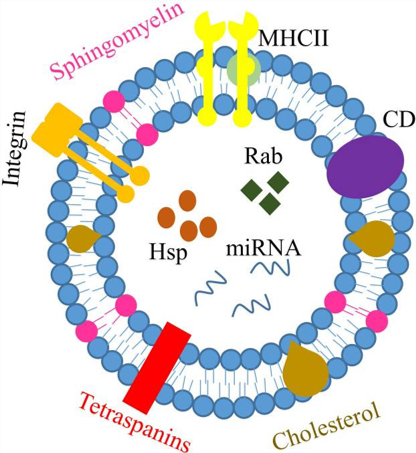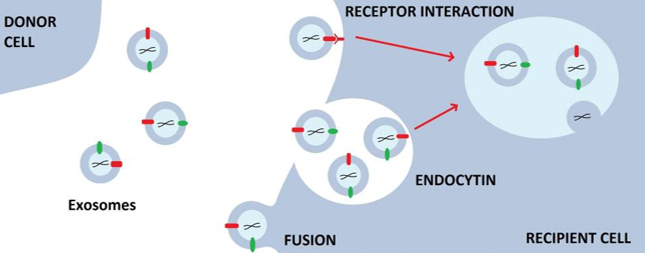Exosome is a type of extracellular vesicle (EV) with a diameter of about 30-150 nm. They are secreted by all cell types and can be found in most body fluids, including blood, saliva, and urine. Exosomes are "nanospheres" with bilayer membranes, which contain a wide array of substances from parent cells, such as microRNAs, mRNA expression, lncRNA, DNA, lipids, peptides, and proteins (including oncoprotein, Tumor suppressor genes, transcription regulators and splicing factors). The composition of exosomes is critical because they can be used as biomarkers and provide an indication of their function in biological processes.
 Figure 1: Composition of exosomes
Figure 1: Composition of exosomes
Depending on the source of the exosomes, they have different functions. Generally, the function of exosomes promotes intercellular communication throughout the body in a target-specific manner. Currently, exosomes are known to participate in many biological processes, including maturation of red blood cells, elimination of unnecessary proteins and RNA, antigen presentation in immune responses, coagulation, inflammation, and angiogenesis.
In addition to normal biological processes, exosomes have been found to be associated with many common diseases, such as cancer, neurodegenerative diseases (Parkinson's disease, etc.), myocardial infarction, and AIDS.
Given that exosomes can be isolated from almost any cell, participate in intercellular communication, and participate in normal and pathobiological mechanisms, exosomes are used as a diagnostic and therapeutic method in more and more studies.
Exosomes can exert their biological effects in a number of ways:
The recipient cell absorbs the exosomes through cytocytosis or phagocytosis, and the contents of the exosomes are released in the recipient cells, thereby affecting the function of the recipient cells.
 Figure 2: How do exosomes exert biological effects?
Figure 2: How do exosomes exert biological effects?
Exosomes can mediate the pathological processes of various diseases, and regulating disease-related exosomes can play a role in relieving or treating diseases. This can be achieved by interfering with the generation, release, uptake and functional contents of related exosomes.
Because exosomes are rich in biologically active substances, they have a certain therapeutic potential. For example, stem cell-derived exosomes have the functions of promoting angiogenesis, inhibiting apoptosis, promoting cell proliferation, and releasing immunoregulatory substances, and have certain application value in the field of regenerative medicine.
Exosomes can carry signal molecules such as RNA, DNA, and proteins, so they can be used as therapeutic carriers for therapeutic macromolecules. For example, exosomes can be used as therapeutic carriers for therapeutic nucleic acid drugs, delivering mRNA, miRNA, etc. to target cells, thereby regulating the expression of target genes to play a therapeutic role. Compared with previous non-viral drug delivery vehicles, exosomes as drug delivery vehicles have higher biocompatibility and lower immunogenicity can be obtained from patient autologous cell culture and can pass the blood-brain barrier.
Exosome therapy, as a new treatment method, brings some new opportunities for the current treatment of some refractory diseases or the development of drugs with difficult drug targets.
Stem cell-derived exosomes can also play a role in promoting cell regeneration or repair. In this way, it can play a role instead of stem cells, thereby avoiding the risk of immune infection and cancer caused by stem cell therapy.
The expression of tissue antigens on the surface of exosome membranes provides a biological basis for the development of organ, tissue or cell division drugs.
In addition, exosomes have low immunogenicity, do not cause adverse reactions in the immune system, can be repeated, and can pass non-invasively through many tissue barriers (such as blood-brain barrier, etc.).
Learn More about Our Ability of Exosome Drug delivery
Exosomes are nanosized vesicles containing proteins, lipids, DNA, mRNA, miRNA, lncRNA, and other bioactive molecules, reflecting the molecular profile of their parent cells.
Exosomes interact with recipient cells through receptor binding, membrane fusion, or endocytosis, delivering bioactive molecules that regulate cellular signaling and function.
We use ultracentrifugation, size-exclusion chromatography, precipitation, and immunoaffinity capture to obtain high-purity exosome populations for research use.
Exosomes provide high biocompatibility, low immunogenicity, and natural ability to cross biological barriers, enabling efficient delivery of RNA, DNA, or proteins to target cells.
Yes, we engineer exosomes to carry specific nucleic acids, proteins, or targeting ligands, enabling precise delivery and functional modulation for various research applications.
We implement multiple characterization methods including NTA, TEM, and Western blot to ensure consistent vesicle size, integrity, and marker expression in all preparations.
Ref: